Unused swine barns can be converted into facilities for rearing other profitable agricultural products, such as fish. The key to success is to identify markets for the products and spend as little as possible on the conversion.
Tank culture offers an alternative to traditional pond aquaculture and can be used in indoor facilities such as unused barns. Tank culture systems are examples of recirculating aquaculture systems (RASs). In many cases, equipment or structures already in place in a former hog operation can be converted for use in a RAS. By retrofitting equipment and reusing water, you can develop a RAS to produce fish in a cost-effective manner. The conversion can require a significant investment, however, so before beginning, gather as much research-based information as possible and learn about fish culture, water quality, marketing and other aspects of aquaculture. Then, develop plans for the enterprise and identify potential markets for your product. Many factors affect the ability to produce fish cost-effectively, including component capital costs, operating costs and efficient management of the fish culture system, so the research you do will help you make an informed decision.
Several fish species can be produced in Missouri using a RAS. Potential warm-water fish include sunfish, sunfish hybrids, hybrid striped bass, large-mouth bass and channel catfish. Trout can be raised in cold water where abundant spring or cold well water is available.
This guide provides basic information on RAS technology and converting a swine barn into an aquaculture enterprise (Figure 1). The set-up costs are expensive, so thorough planning of the conversion and operation is critical for successful, profitable production.
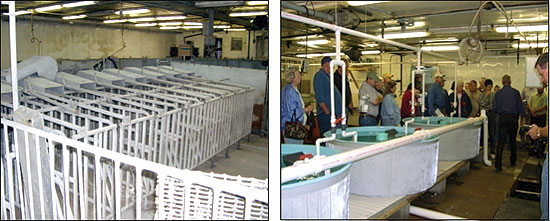
Figure 1. This unused swine barn (a) was converted into an active aquaculture facility (b).
Recirculating aquaculture systems
Recirculating system technology enables fish farmers to raise a uniform product while greatly reducing the amount of water used by treating and reusing it, and to concentrate fish in a small space, greatly reducing the labor for handling, harvesting and processing. Recirculating systems that use tanks for production are ideal for indoor facilities.
Like an aquarium, a RAS circulates water to the tank with a pump, and then filters the water and recirculates it back to the tank. A minimal amount of water is replaced during the circulation process, and this amount is controlled by the water input setting. Most of the water is recirculated several times before being discharged.
A RAS consists of containers to hold the fish; aerators, or air blowers, to oxygenate the water; devices to remove solids; biological filters (biofilters) to remove debris and fish wastes; pumps to move the water; and plumbing equipment. Each of these components is described in more detail below. Equipment and design features of the swine barn can be converted into RAS components. For example, the flush tank can be used as the biofilter, the rack structures and tender foot material can be used to support the fish tanks, and the waste pit can be used to remove sediment, which can be flushed through the pit into the existing lagoon that was used for the hog operation wastes. The new components to be added include tanks, valves and piping, a pump and a blower or aeration devices.
This guide briefly describes the technical aspects of tank culture, component design, and performance. To increase your chances of success with an aquaculture enterprise, however, refer to the publications listed in the Additional resources section for more in-depth information.
Introduction to fish production
In addition to learning about the components of a RAS, you will need to learn about other facets of fish production:
- Aquaculture and fish culture basics
- Selecting potential fish species
- Assessing your facility, equipment and water supply
- Establishing a product market
- Creating a budget
These five facets of fish production are briefly described below and in more depth in some of the resources listed in the Additional resources section.
Aquaculture and fish culture basics
To succeed in aquaculture production, you need to thoroughly understand water chemistry and the biology of the fish species you are considering. Proper water chemistry and biology interact to create a fish culture system in which healthy fish will grow in a time interval that will ensure a profit. Fish culture systems are dynamic — a change in one component, such as a water quality parameter, will cause changes in another — and understanding their dynamics is essential for successful fish farming.
Water quality
A producer with a RAS must be an effective water quality manager. Maintaining good water quality is essential because poor water quality can reduce growth rates, cause disease, stress the fish and foul the filters.
Different species of fish have different water requirements. You need to know the specific water requirements for the species you are considering producing and how to manage the water to maintain them. Fish species have tolerances for varying levels of these water quality parameters:
- Dissolved oxygen
- Ammonia-nitrogen
- Nitrite-nitrogen
- Nitrate
- pH (degree of acidity)
- Alkalinity (a measure of calcium and magnesium carbonate content)
- Hardness
In addition, water velocity (flow rate), fish loading (the weight of fish per rate of water flow: pounds per gallon per minute), density (the weight of fish per volume of water), feeding rate and turnover directly influence water quality. All of these parameters should be monitored and recorded regularly.
The filtering system removes suspended solids when recycling the water. Solids that settle on the bottom are removed by siphoning. Dissolved solids are diluted with the addition of fresh water and are biochemically broken down into harmless products by the biofilter.
As in other livestock production, the management of waste products is a significant cost of production and operation. With fish, both solid and soluble wastes must be considered. Uneaten feeds eventually decompose within the system and produce additional ammonia, which is toxic to fish.
Cost-effective water treatment components are available that efficiently remove waste solids, oxidize ammonia and nitrite-nitrogen, remove carbon dioxide and oxygenate the water before returning it for reuse. Success or failure of these systems is directly related to water management strategies. Investing in a water quality sampling kit is highly recommended. These kits are easy to use and produce reliable results. Record each parameter daily, and watch for changes, which are the first sign that the water needs to be adjusted.
Feed
Feed is often the biggest expense in commercial fish production. Therefore, to realize a profit, a producer should feed only the amount necessary for maximum growth. Knowing the size and weight of fish in the system allows you to calculate the amount of feed needed, which has been determined for most commercial species and is typically 3 percent of body weight. You can calculate the amount to feed in four steps:
- Weigh and measure a representative sample of fish.
- Average their weights (sum of weights divided by total number of fish weighed).
- Multiply the average weight by the number of fish in the system.
- Multiply the result by 0.03.
Feed must be fresh. Store it in a dry place to prevent molding. Fish growth depends not only on water quality but also on a high-quality diet provided at rates that prevent waste.
Fish can be fed by hand or with automatic feeders.
Fish health
Monitoring the health of your fish is critical to prevent a disease outbreak. Many pathogens are frequently found with the fish and do not cause problems — unless the fish are stressed. Know your fish! Fish behaving differently or going off feed is a warning. Record any mortality daily. Losing a few fish daily is a sign of a chronic problem; losing a greatly increasing number daily is a sign of higher mortalities and an uncontrollable loss of fish.
Disease can be prevented by having a biosecurity plan. [Refer to USDA Southern Regional Aquaculture Center (SRAC) Biosecurity in Aquaculture fact sheets for information on developing a biosecurity plan; PDFs available from SRAC under Diseases.] Also, having a working relationship with a trained fish health specialist or veterinarian is extremely important because very few medicines have been approved to treat fish diseases.
Selecting potential fish species
Several species of fish have potential to be produced in RASs. Fish species that are commonly produced in RASs include sunfish, including crappie and bluegill; large-mouth bass; hybrid striped bass; yellow perch; and tilapia. Many of the sunfish and black bass are native to Missouri and are included on the Missouri Department of Conservation’s approved aquatic species list (PDF). Raising tilapia or other nonnative species requires special permission from the Conservation Department. To ensure regulatory compliance, refer to the Wildlife Code of Missouri.
In Missouri, bluegill and hybrid striped bass are excellent species for producing in RASs. They grow well at water temperatures that can be maintained without water heating equipment, and they have the potential to be marketed as a food fish in the state. Both species will grow well in water maintained at 70 to 78 degrees F. Crappie, although difficult to feed-train, can be grown at lower temperatures of 60 to 65 degrees F.
Assessing your facility
Below is a list of the minimum requirements for retrofitting an unused swine facility for aquaculture production. As you review the list, determine what existing equipment in your facility can be used or easily adapted.
- Reliable supply of high-quality water. Well water is preferred. If district water is used, residual chlorine must be removed by using a charcoal filter.
- Large sediment pit that empties into a lagoon. The sediment pit is used for the removal of solids, fish waste, excess feed, etc.
- Flush tanks. Flush tanks can be used as biofilters (Figure 2a).
- Rack systems. The racks can be used to support the fish-rearing tanks (Figure 2b).
- Reliable electrical supply and backup generator that can be operated from a tractor power take-off. An LP or natural gas-powered generator with an automatic switching system is the most reliable.
- Telephone alarm system. An alarm system for notifying operator of pump, blower or other electrical supply problems is desirable.
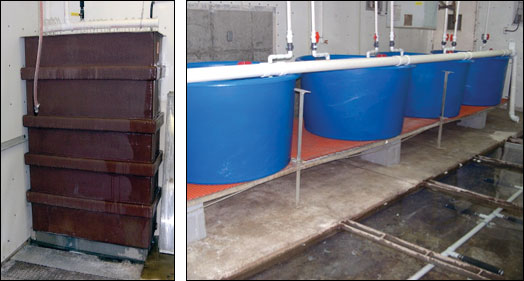
Figure 2. Existing equipment may be retrofitted for aquaculture production: (a) Flush tanks can be converted to biofilters, and (b) racks can be used to support fish-rearing tanks.
Establishing a product market
Determine who will buy your fish and in what form they want their product. The final product could be live fish, dressed fish, filleted fish or fish steaks (Figure 3). Producers selling fish for food markets and human consumption must comply with local and federal food safety and processing regulations. The Food and Drug Administration's (FDA) Fish and Fishery Products Hazards and Controls Guidance provides information about the regulatory requirements for processing seafood for human consumption. The FDA also requires the development and implementation of a hazard analysis and critical control point (HACCP) plan. See the online HACCP guide and training. The guide provides information that can help in the development of a HACCP plan and provides additional guidance on complying with FDA regulations. Producers are strongly encouraged to thoroughly review relevant documents and take HACCP training.
Many producers sell their fish directly to restaurants, at farmers markets or to seafood distributors. Determine where you will sell your fish, and check the local health department regulations. Then, determine how many fish will be sold on each date and ensure that you meet the demand. The Missouri Department of Agriculture has aquaculture marketing specialists who can help in marketing your product.
You also need to determine how you will get your product to market. Live fish need to be hauled in aerated water, and processed fish need to be kept cold at the proper temperature.
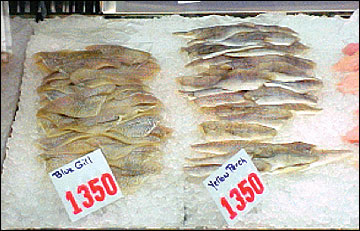 Figure 3. Before investing in the conversion of your unused barn, establish a market for your product — identify who will buy your fish and in what form, whether live, filleted, dressed or as steaks.)
Figure 3. Before investing in the conversion of your unused barn, establish a market for your product — identify who will buy your fish and in what form, whether live, filleted, dressed or as steaks.)
Creating a budget
Creating a budget will help you to determine if your proposed aquaculture enterprise is likely to be profitable and to estimate the market value of your proposed product. If you skip this step, you risk producing a unmarketable product.
Sketch a proposed layout to help you determine what equipment is needed for the conversion (Figure 4). Then, list the current prices for the equipment and for the fish, utilities, labor and other costs. Use realistic numbers in your budget.
The example budget in Figure 5 is for a system producing 40,000 to 80,000 pounds of fish annually (80,000-gallon system). Smaller systems would have a higher initial capital cost per pound of production. The building cost per pound is provided in terms of the cost of a new building. This value would be less if the building were older with initial building cost "retired." A major advantage of retrofitting an older building is the reduction in initial capital investment. Costs are given in terms of fish cultured at lower density and fed a higher protein feed (such as bass) as opposed to a fish cultured at higher density and fed a lower protein feed (such as tilapia). In both cases, the food conversion ratio is assumed as 1.5-to-1, and fish survival is assumed at 85% of stocked number.
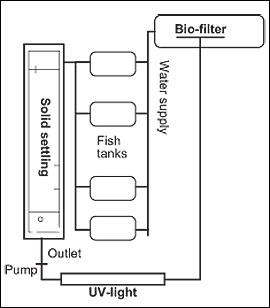 Figure 4. Sketch a proposed layout that describes the equipment and components that will be needed. The biofilter is the center of a RAS and removes dissolved toxic dissolved ammonia from the system.
Figure 4. Sketch a proposed layout that describes the equipment and components that will be needed. The biofilter is the center of a RAS and removes dissolved toxic dissolved ammonia from the system.
Sample Budget, Medium/High Density System Cost (dollars per pound)
| Costs | Density | |
|---|---|---|
| Medium | High | |
| Fixed costs | ||
| Building | 0.23 | 0.12 |
| Climate control | 0.11 | 0.06 |
| Tanks | 0.18 | 0.09 |
| Aeration | 0.08 | 0.08 |
| Biofilter | 0.07 | 0.07 |
| Solids filter | 0.06 | 0.06 |
| Generator | 0.04 | 0.04 |
| Pumps | 0.01 | 0.01 |
| Total fixed costs | 0.78 | 0.53 |
| Variable costs | ||
| Fish | 0.78 | 0.78 |
| Feed | 2.29 | 1.47 |
| Energy | 0.50 | 0.36 |
| Labor | 0.64 | 0.64 |
| Total variable costs | 4.21 | 3.25 |
| TOTAL COSTS | 4.99 | 3.78 |
Figure 5. The costs in this sample budget are illustrative only. Enter current costs when creating a budget for your operation.
Components of a RAS
A RAS has several components that are crucial for successful production of fish. A general description of these components and how they function is provided below.
Biofilter
The biofilter is a container that holds media (described in more detail in the next section) in which beneficial nitrifying bacteria live and through which water flows. The biofilter supports nitrification, the process through which ammonia is converted to nitrates. Ammonia is produced as waste from fish metabolism and is the primary dissolved waste in a recirculating system. Ammonia is very toxic to fish and must be removed from the water, which is what the nitrifying bacteria essentially do. There are two types of nitrifying bacteria: Nitrosomonas and Nitrobacter. Together, they remove ammonia from the water by converting it to a harmless substance. First, Nitrosomonas oxidizes the ammonia to nitrite, and then Nitrobacter converts the harmful nitrites to harmless nitrates. Nitrates at normal levels are nontoxic to fish.
The biofilter must be designed to hold enough biomass of bacteria to eliminate the production of ammonia. The capacity of the biofilter is determined by the surface area of media necessary to support the amount of bacteria needed to remove ammonia from the water. The general assumption is that about 2.5 percent of feed becomes total ammonia nitrogen (TAN). Note, however, that pH and temperature affect the TAN. Basically, 1 cubic foot of media provides enough surface area to support the bacteria needed to convert ammonia from 1.0 to 1.4 pounds of feed per day per cubic foot of medium. Several types of media can be used in the biofilter. Most suppliers have technicians who can help you determine the proper type and amount of media to use. In addition to commercially made products, sand, rock and shells can be as biofilter media.
The capacity of the biofilter limits the fish load (size and number of fish to put into a RAS), feeding rates and water flow rate. Once any of these three factors is greater than the biofilter can handle, the system becomes overloaded and unhealthy for the fish. At this point, the water needs to be treated, diluted, siphoned or otherwise managed to maintain good water quality.
Although not its primary function, the biofilter also degasses water and can aerate water if the filter is elevated and provides a drop for the outgoing water.
Biofilter media
The biofilter media is critical to the biofilter's effectiveness and influences set-up costs. Most media are rated by square feet of surface area per cubic foot of media. Material prices vary, and although their initial costs may be higher, materials with high surface area per cubic foot will provide the best efficiency.
Flush tanks from the swine operation were converted to biofilters. The converted flush tank biofilters contain a substrate called BioFill that is rated to have 250 square feet of surface per cubic foot of media, which is generally sufficient. The media is relatively inexpensive but has some properties that are not as beneficial as other material. In general, the higher the surface area the better, but materials become more expensive and may not be cost-effective to use.
When starting a new biofilter, allow time for the bacteria to build up to a sufficient quantity to handle a full load of fish. Stock only a few fish in the tank as you get the biofilter working, then gradually increase fish stocking as bacteria mass and capability increases. Most systems take 45 to 60 days to become fully operational. Be cautious during start-up by initiating the biofilter with a minimum fish load. Often a biofilter can be made ready to handle a full fish load more quickly with the addition of a specially prepared bacteria culture, which is available from most aquaculture supply companies.
Biofilter capacity design
Fish loading depends on biofilter capacity, as well as water flow, tank size and feeding rate. The ideal capacity or size of the biofilter is determined by the amount of feed fed daily. For example, assume that a tank can support no more than half a pound of near-market-size fish per gallon and that the fish are receiving about 2 percent feed per day. The maximum load of a 100-gallon tank would be 50 pounds of fish fed 1 pound of feed per day producing about 0.225 pounds of TAN, requiring 1 cubic foot of media (50 pounds × 0.02 = 1 pound). The design criterion has shown that the capacity of feed in the tank is one pound per day, so the amount of media needed is 1 cubic foot. Assuming that smaller fish in the tank are fed at twice the rate of the larger fish, the capacity is reduced by ½ (25 pounds of 4-inch fish fed 4 percent of their body weight daily would require 1 pound of feed: 25 pounds × 0.04 = 1 pound).
Aeration
Because fish and decomposing organic materials both use oxygen, the water in the system must be aerated. An aeration system consists of blowers, which produce the air, and aeration devices, which diffuse the air into the water and determine the efficiency of the oxygen transfer. The aerators also create water movement, or flow, to allow removal of suspended solids.
Highly efficient regenerative blowers can provide the oxygen needed for aeration. These high-volume, low-pressure blowers provide dissolved oxygen for fish survival and metabolism, and provide oxygen to the biofilters for the nitrification process. Regenerative blowers come in many sizes, so be sure to choose the appropriate size for your system.
The tanks are aerated by simple manifold aerators (Figure 6). A manifold aerator releases dissolved oxygen on one side so that it is deflected into the water to create a directional flow. The circular flow deposits most of the waste matter in the center where it can more easily be removed. Some of the wastes will go out the central drain. Solids should be removed quickly to prevent an adverse effect on water quality. When solid wastes accumulate, the organic matter begins to decompose, which uses dissolved oxygen.
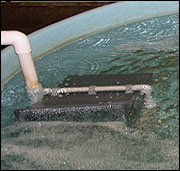 Figure 6. Manifold aerators not only provide oxygen but also create a circular flow that aids in waste removal.
Figure 6. Manifold aerators not only provide oxygen but also create a circular flow that aids in waste removal.
Water flow
The water flow rate directly influences water quality. The flow rate depends on the total volume of water in the tanks, the replacement water coming in and the capacity of the pumps to move the water. Think of the water as a fluid conveyor bringing in dissolved oxygen and removing harmful wastes. The conveyor must move fast enough to supply enough dissolved oxygen for fish survival and growth and to remove dissolved and solid wastes.
Water flow rate can be measured by collecting the water coming into the tank in 6 seconds, multiplying the number of gallons collected by 10 to find the gallons per minute, and dividing the tank volume (gallons) by the gallons per minute. The result is the number of minutes it will take to replace the water in the tank.
water flow rate = tank volume ÷ (gallons in 6 seconds × 10)
The best management practice is to replace the total water volume every 30 minutes. This replacement is referred to as the water "turnover."
Plumbing
The fish tank water flows from the biofilter through PVC pipe that is supported by the fish tanks (Figure 7). Because this pipe has no drop, it must have a diameter large enough to prevent any reduction in water flow. Each tank has a corresponding valve (orange colored) and a vertical inlet pipe that is submerged in the tank. Holes are drilled on one side of the inlet pipe and are distributed in the same direction as the shield on the aerator (Figure 8). The direction of the flow enhances water movement and waste removal. The outlet pipe (PVC) from each tank is normally as large as the main supply line. If multiple tanks are drained into a common exit pipe, the pipe must be large enough to receive the total volume of the tanks when the drain is pulled. Pulling the drain is an easy way to remove wastes that have accumulated in the center of the tanks.
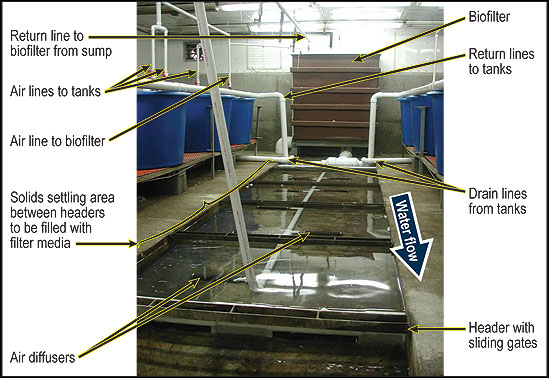
Figure 7. This typical conversion shows select components and the water and air flow.
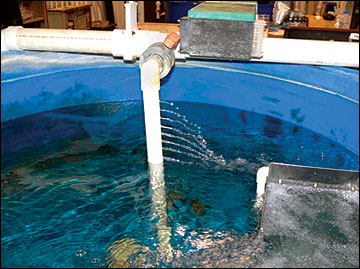 Figure 8. A valve (orange-colored) leads to the water inlet pipe that is submerged in each tank.
Figure 8. A valve (orange-colored) leads to the water inlet pipe that is submerged in each tank.
Waste pit
The waste pit is used primarily for the settling and removal of solids (Figures 9 and 10). Water must be held in the pit for at least 20 minutes to settle most solids out of the system. Holding the water longer will enhance removal of solids to the point that the tanks will require less frequent flushing for cleaning.
A blocking device in the waste pit causes the water to pool and can increase the time water is held in the pit. Slats on the bottom of the blocking device direct most of the flow along the bottom of the pit. The slats need to be easy to remove for when the waste pit needs cleaning.
Air stones or other air-supply devices can enhance removal of settled waste material by resuspending wastes before the slats are pulled. Air stones prevent further consumption of dissolved oxygen due to decomposition of organic material.
Finally, the best setup is to have a drain at the end of the waste pit that leads to the lagoon. To remove solids, simply pull the standpipe to the lagoon exit. To clean the pit, remove the slats and brush accumulated debris towards the standpipe. Then, pull the standpipe and the wastes will be transported out to the lagoon.
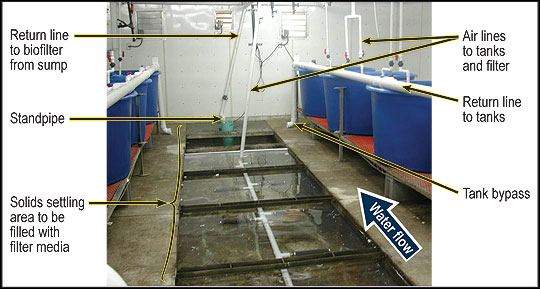
Figure 9. This waste pit and solids settling configuration shows select components and the water and air flow.
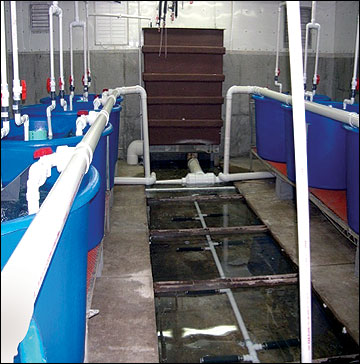 Figure 10. The waste pit allows solids to settle and be removed to the lagoon through a drain at the end of the pit.
Figure 10. The waste pit allows solids to settle and be removed to the lagoon through a drain at the end of the pit.
Managing RAS water quality
Water quality management is key to raising fish, especially in a RAS. Successfully raising fish in a RAS depends on understanding water chemistry and maintaining various water quality parameters at or above required minimum levels.
Although other water quality parameters are operating in a recycle system, the water qualities mentioned below are the most important and should be monitored and recorded daily. An inexpensive oxygen meter and a water quality test kit that measures these basic parameters are required tools for serious fish farmers. Knowing how to test the water with these tools and interpret the results is a necessity for aquaculture success. These meters and test kits are available from most aquaculture suppliers.
- Oxygen
Fish require dissolved oxygen to live. Low oxygen stresses fish and limits their growth. The bacteria that convert soluble wastes to nontoxic forms also require oxygen. Oxygen levels below 5.0 ppm (parts per million) can stress fish and cause them to eat less and metabolize their food more slowly. - pH
pH is a measure of how acidic or basic water is. It is related to the balance of positive hydrogen (H+) and negative hydroxide (OH-) ions in the water. pH is especially important in recycling systems, where water tends to become more acidic. Fish use oxygen and give off carbon dioxide (CO2) when they breathe. The CO2 mixes with water to form a weak acid. In addition, the conversion of ammonia (NH4+) to nitrite (NO2) and nitrate (NO3) together with water forms acids. Therefore, over time, recycle systems become more acidic, especially in waters that are not buffered well. Buffering protects the water from pH changes and has to do with the levels of calcium carbonate (CaCO3) in the water, or the water's alkalinity. High alkalinity indicates a good buffering system. pH does not fluctuate widely in buffered waters. pH values between 7 and 8 are adequate in a RAS. - Alkalinity
As mentioned above, alkalinity is a measure of the calcium carbonate concentration in water. Water with alkalinity of 100 ppm or above has good buffering capacity. Water from wells or other sources in limestone areas, such as Missouri, tend to have high alkalinity. - Ammonia
Two types of ammonia exist in an aquaculture system: ionized ammonium (NH4+) and un-ionized ammonia (NH3). The un-ionized form is toxic and occurs in higher concentrations at higher pH. Fish species have varying tolerances to ammonia; however, in general, maintaining un-ionized ammonia levels below 0.03 ppm is best. Conversion tables are available from a variety of sources, including the SRAC water quality fact sheet Ammonia in Fish Ponds, that can give you the un-ionized ammonia level if you know the water's temperature and pH.
Conclusions
As shown in Figure 11, a swine barn can be converted to a commercial aquaculture enterprise using the techniques described in this guide. However, raising and producing fish in a RAS requires skills and knowledge that differ from those needed in traditional livestock enterprises. As a new aquaculture producer, in addition to acquiring the needed skills and knowledge, develop marketing channels for the aquaculture products you plan to produce before you make any investment.
Also, start small. Make a minimum investment to gain initial skills in aquaculture, equipment maintenance, water quality management and aquaculture product marketing. Learn about fish culture and how to operate and manage a RAS. The skills and knowledge you gain will enhance your chances of success and potentially lead to a profitable enterprise. Profitability will ultimately depend on keeping costs low and successfully marketing your fish products.
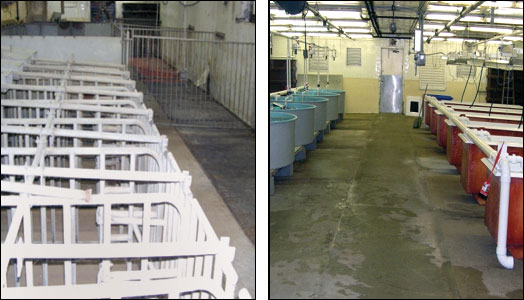
Figure 11. Retrofitting an existing building such as a swine barn (a) for aquaculture production (b) can lead to a profitable enterprise.
Additional resources
Excellent aquaculture information is available from the Southern Regional Aquaculture Center. The information is organized so that species descriptions, techniques, systems and other data may be easily found. Most of these free fact sheets are compilations of many years of research. Some SRAC fact sheets specific to RASs are listed below.
Other fish farmers can be an excellent resource to new and experienced producers alike. Discussing issues and learning from the experiences of others can be a great help.
The Missouri Department of Agriculture's aquaculture program offers helps and guidance on getting started, meeting state and federal regulations, and marketing. It also provides an online resource directory.
The Missouri Department of Conservation's Wildlife Code (Title 3, Division 10 of the Missouri Code of State Regulations) provides a list of approved aquatic species and regulations for their production.
Publications
- Dunning, R.D., T.M. Losordo, and A.O. Hobbs. 1998. The economics of recirculating tank systems: A spreadsheet for individual analysis (Publication No. 456). Stoneville, MS: Southern Regional Aquaculture Center.
- Hargreaves, J.A., and C.S. Tucker. 2002. Measuring dissolved oxygen concentration in aquaculture (Publication No. 4601). Stoneville, MS: Southern Regional Aquaculture Center.
- Losordo, T.M., M.P. Masser, and J. Rakocy. 1998. Recirculating aquaculture tank production systems: An overview of critical considerations (Publication No. 451). Stoneville, MS: Southern Regional Aquaculture Center.
- Losordo, T.M., M.P. Masser, and J.E. Rakocy. 1999. Recirculating aquaculture tank production systems: A review of component options (Publication No. 453). Stoneville, MS: Southern Regional Aquaculture Center.
- Masser, M.P., J. Rakocy, and T.M. Losordo. 1999. Recirculating aquaculture tank production systems: Management of recirculating systems (Publication No. 452). Stoneville, MS: Southern Regional Aquaculture Center.
- Rakocy, J.E., T.M. Losordo, and M.P. Masser. 1992. Recirculating aquaculture tank production systems: Integrating fish and plant culture (Publication No. 454). Stoneville, MS: Southern Regional Aquaculture Center.
- Swann, L., ed. 1991. Second annual workshop: Commercial aquaculture using water recirculating systems (PDF). (No longer available online.) West Lafayette, IN: Purdue University Cooperative Extension Service.